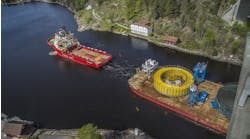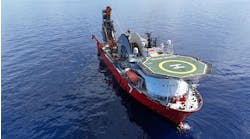Knut Flage, Nexans Norway
null
Nexans developed Spider, a new steep terrain dredger/subsea intervention vehicle, to meet the challenge of the demanding seafloor terrain of the Storegga slide area in the Ormen Lange gas field pipe/umbilical corridors on the Norwegian Continental Shelf.
This slide forms an escarpment from the relatively flat continental shelf at a water depth of approximately 200 m, to its base at around 800 m. The slope of the slide area can be as great as 35°, with very uneven topography and variable geotechnical properties. The escarpment entry and exit areas, plus the uneven slope surface, posed particular challenges to the pipe designer, and the requirement for reducing freespans was identified early in the field development process.
Two principal methods were originally identified for pipeline corridor corrections prior to pipelay; rockdumping, and a dredging system. Rockdumping was considered unfeasible on the steep slopes, so a pre-lay dredging system became critical to the field development.
Norsk Hydro, operator of the Ormen Lange gas field development, had previously used Nexans’ Capjet trenching units on several other projects. Shortly thereafter, we began to investigate the possibility of adapting the concept to a dredging unit capable of leveling or flattening the seabed in one particular area by a combination of water jetting and suction to remove large volumes of soil. The following design criteria were identified for what became known as the Spider project:
• The unit should be able to operate on steep slopes and on uneven seabeds;
• The unit should have an efficient and flexible dredging unit capable of high precision dredging;
• The unit should be able to operate in zero visibility;
•The unit should be based on Capjet technology and with future adaptations such as trenchers and dredgers in mind; and
• The unit should have capacity for the high soil strength found in the areas.
Adapting a forest logger
In developing the Spider, the Nexans team identified a highly successful walking forest logging machine (Menzimuck) and entered into an exclusive agreement with the company to adapt it for subsea use. The design features four individually controlled legs, with powered wheels/tracks and slewing of the top dredging unit in relation to the bottom walking leg structure.
High precision dredging
Furthermore, in close cooperation with the Norwegian company GTO, a specialist in ejector-based dredging systems, we developed a purpose-made dredging system for efficient, high precision dredging.
This places the dredging head on an excavator type of dredging arm, and utilizes Capjet water jetting technology together with GTO’s ejector.
The Spider is built to work in water depths of approximately 1,000 m. Its movements are controlled by operators located aboard a support vessel, with power and signals between the vessel and the subsea unit supplied through a special umbilical cable designed by Nexans.
Zero visibility operation
The operator follows the Spider’s movements via underwater cameras. However, when material stirred up from the seabed reduces visibility, an alternative is provided by a virtual 3D computer image.
Norsk Hydro had already carried out a thorough mapping of the Ormen Lange area and developed a detailed 3D terrain model for the pipe design process. This was taken a step further when the requirement to use the 3D terrain models to control and document all installation work was introduced to all contractors on the field.
Comprehensive LBL (long base line) arrays were put in place for accurate positioning within the 3D terrain model. Nexans responded by developing new software for real-time control of the Spider unit, complete with all major systems and active interaction with the 3D terrain during dredging operations.
Prototype
The 12-metric ton Spider prototype entered operation on the Ormen Lange field in 2004, excavating some 2,500 cu m of soil in the most challenging area of the slope. This proved the effectiveness of the concept, which was then refined in the more powerful 15-metric ton Spider II unit that operated from the vesselGeobayfor 16 weeks in 2005, working alongside the original prototype.
The 2005 program included parallel dredging operations with both units, as well as individual operations. The designated scope of dredging in the escarpment area - around 16,000 cu m of hard soils -- was completed in September 2005.
The Spider units proved that high accuracy (within 50 cu m) dredging in zero visibility, in steep slopes, and on very uneven seabeds can be performed efficiently and safely.
The Spider units were designed to be flexible. Currently both dredging units are being converted to 1 MW trenching units for the 2006 season. One will continue with Norsk Hydro on the Ormen Lange field (together with two of Nexans’original 1 MW Capjet units) to perform the post-lay trenching work in 2006/2007, while the other will probably transfer to another project in the North Sea.
The Spider equipment modules are readily available, and when needed, the units can be converted back to dredging operation in just a few days.•







